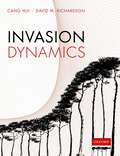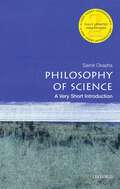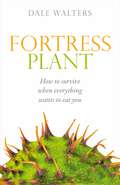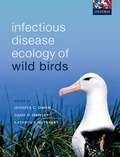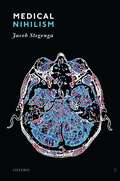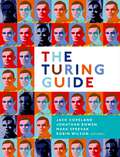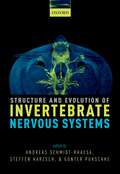- Table View
- List View
Invasion Dynamics
by Cang Hui David M. RichardsonHumans have moved organisms around the world for centuries but it is only relatively recently that invasion ecology has grown into a mainstream research field. This book examines both the spread and impact dynamics of invasive species, placing the science of invasion biology on a new, more rigorous, theoretical footing, and proposing a concept of adaptive networks as the foundation for future research. Biological invasions are considered not as simple actions of invaders and reactions of invaded ecosystems, but as co-evolving complex adaptive systems with emergent features of network complexity and invasibility. Invasion Dynamics focuses on the ecology of invasive species and their impacts in recipient social-ecological systems. It discusses not only key advances and challenges within the traditional domain of invasion ecology, but introduces approaches, concepts, and insights from many other disciplines such as complexity science, systems science, and ecology more broadly. It will be of great value to invasion biologists analyzing spread and/or impact dynamics as well as other ecologists interested in spread processes or habitat management.
Invasion Dynamics
by David M. Richardson Cang HuiHumans have moved organisms around the world for centuries but it is only relatively recently that invasion ecology has grown into a mainstream research field. This book examines both the spread and impact dynamics of invasive species, placing the science of invasion biology on a new, more rigorous, theoretical footing, and proposing a concept of adaptive networks as the foundation for future research. Biological invasions are considered not as simple actions of invaders and reactions of invaded ecosystems, but as co-evolving complex adaptive systems with emergent features of network complexity and invasibility. Invasion Dynamics focuses on the ecology of invasive species and their impacts in recipient social-ecological systems. It discusses not only key advances and challenges within the traditional domain of invasion ecology, but introduces approaches, concepts, and insights from many other disciplines such as complexity science, systems science, and ecology more broadly. It will be of great value to invasion biologists analyzing spread and/or impact dynamics as well as other ecologists interested in spread processes or habitat management.
Philosophy of Science: Very Short Introduction (Very Short Introductions)
by Samir OkashaHow much faith should we place in what scientists tell us? Is it possible for scientific knowledge to be fully 'objective'? What, really, can be defined as science? In the second edition of this Very Short Introduction, Samir Okasha explores the main themes and theories of contemporary philosophy of science, and investigates fascinating, challenging questions such as these. Starting at the very beginning, with a concise overview of the history of science, Okasha examines the nature of fundamental practices such as reasoning, causation, and explanation. Looking at scientific revolutions and the issue of scientific change, he asks whether there is a discernible pattern to the way scientific ideas change over time, and discusses realist versus anti-realist attitudes towards science. He finishes by considering science today, and the social and ethical philosophical questions surrounding modern science. ABOUT THE SERIES: The Very Short Introductions series from Oxford University Press contains hundreds of titles in almost every subject area. These pocket-sized books are the perfect way to get ahead in a new subject quickly. Our expert authors combine facts, analysis, perspective, new ideas, and enthusiasm to make interesting and challenging topics highly readable.
Philosophy of Science: Very Short Introduction (Very Short Introductions #1)
by Samir OkashaHow much faith should we place in what scientists tell us? Is it possible for scientific knowledge to be fully 'objective'? What, really, can be defined as science? In the second edition of this Very Short Introduction, Samir Okasha explores the main themes and theories of contemporary philosophy of science, and investigates fascinating, challenging questions such as these. Starting at the very beginning, with a concise overview of the history of science, Okasha examines the nature of fundamental practices such as reasoning, causation, and explanation. Looking at scientific revolutions and the issue of scientific change, he asks whether there is a discernible pattern to the way scientific ideas change over time, and discusses realist versus anti-realist attitudes towards science. He finishes by considering science today, and the social and ethical philosophical questions surrounding modern science. ABOUT THE SERIES: The Very Short Introductions series from Oxford University Press contains hundreds of titles in almost every subject area. These pocket-sized books are the perfect way to get ahead in a new subject quickly. Our expert authors combine facts, analysis, perspective, new ideas, and enthusiasm to make interesting and challenging topics highly readable.
Fortress Plant: How to survive when everything wants to eat you
by Dale WaltersThe survival of plants on our planet is nothing short of miraculous. They are virtually stationary packages of food, providing sustenance for a vast array of organisms, ranging from bacteria and fungi, through to insects, and even other plants. But plants are master survivors, having coped with changing environments and evolving predators over much of the history of life on earth. They have surveillance systems and defences that would put most modern armies to shame. They need to have a formidable armoury, because their enemies have sophisticated weaponry of their own. In this often hostile world, battles are fought daily, often to the death. These battles are not trivial - they matter, because life on this fragile planet of ours depends on plants. In this book Dale Walters takes readers on a journey through these battlefields, exploring how predators try to fool plants' surveillance systems and, if they manage to do so, how they gain access to the nourishment they require. Incredibly, successful attackers can manipulate plant function in order to suppress any attempt by the plant to mount defensive action, while at the same time ensuring a steady supply of food for their own survival. Walters shows how plants respond to such attacks, the defences they use, and how the attacked plant can communicate its plight to its neighbours. These skirmishes represent the latest stage in an unending evolutionary war between plants and organisms that feed on them. These battles might be on a micro scale, but they are every bit as fierce, complicated, and fascinating as the battles between animal predators and prey.
Fortress Plant: How to survive when everything wants to eat you
by Dale WaltersThe survival of plants on our planet is nothing short of miraculous. They are virtually stationary packages of food, providing sustenance for a vast array of organisms, ranging from bacteria and fungi, through to insects, and even other plants. But plants are master survivors, having coped with changing environments and evolving predators over much of the history of life on earth. They have surveillance systems and defences that would put most modern armies to shame. They need to have a formidable armoury, because their enemies have sophisticated weaponry of their own. In this often hostile world, battles are fought daily, often to the death. These battles are not trivial - they matter, because life on this fragile planet of ours depends on plants. In this book Dale Walters takes readers on a journey through these battlefields, exploring how predators try to fool plants' surveillance systems and, if they manage to do so, how they gain access to the nourishment they require. Incredibly, successful attackers can manipulate plant function in order to suppress any attempt by the plant to mount defensive action, while at the same time ensuring a steady supply of food for their own survival. Walters shows how plants respond to such attacks, the defences they use, and how the attacked plant can communicate its plight to its neighbours. These skirmishes represent the latest stage in an unending evolutionary war between plants and organisms that feed on them. These battles might be on a micro scale, but they are every bit as fierce, complicated, and fascinating as the battles between animal predators and prey.
Telescopes: A Very Short Introduction (Very Short Introductions)
by Geoff CottrellFrom the first, telescopes have made dramatic revelations about the Universe and our place in it. Galileo's observations of the Moon's cratered surface and discovery of Jupiter's four big satellites profoundly altered the perception of the heavens, overturning a two-thousand year cosmology that held the Earth to be the centre of the Universe. Over the past century, the rapid development of computer technology and sophisticated materials allowed enormous strides in the construction of telescopes. Modern telescopes range from large Earth-based optical telescopes and radio arrays linking up across continents, to space-based telescopes capturing the Universe in infrared, ultraviolet, X-rays, and gamma rays. In combination, they have enabled us to look deep into the Universe and far back in time, capturing phenomena from galactic collisions to the formation of stars and planetary systems, and mapping the faint glow remaining from the Big Bang. In this Very Short Introduction, Dr. Geoff Cottrell describes the basic physics of telescopes, the challenges of overcoming turbulence and distortion from the Earth's atmosphere, and the special techniques used to capture X-rays and gamma rays in space telescopes. He explains the crucial developments in detectors and spectrographs that have enabled the high resolution achieved by modern telescopes, and the hopes for the new generation of telescopes currently being built across the world. ABOUT THE SERIES: The Very Short Introductions series from Oxford University Press contains hundreds of titles in almost every subject area. These pocket-sized books are the perfect way to get ahead in a new subject quickly. Our expert authors combine facts, analysis, perspective, new ideas, and enthusiasm to make interesting and challenging topics highly readable.
Telescopes: A Very Short Introduction (Very Short Introductions)
by Geoff CottrellFrom the first, telescopes have made dramatic revelations about the Universe and our place in it. Galileo's observations of the Moon's cratered surface and discovery of Jupiter's four big satellites profoundly altered the perception of the heavens, overturning a two-thousand year cosmology that held the Earth to be the centre of the Universe. Over the past century, the rapid development of computer technology and sophisticated materials allowed enormous strides in the construction of telescopes. Modern telescopes range from large Earth-based optical telescopes and radio arrays linking up across continents, to space-based telescopes capturing the Universe in infrared, ultraviolet, X-rays, and gamma rays. In combination, they have enabled us to look deep into the Universe and far back in time, capturing phenomena from galactic collisions to the formation of stars and planetary systems, and mapping the faint glow remaining from the Big Bang. In this Very Short Introduction, Dr. Geoff Cottrell describes the basic physics of telescopes, the challenges of overcoming turbulence and distortion from the Earth's atmosphere, and the special techniques used to capture X-rays and gamma rays in space telescopes. He explains the crucial developments in detectors and spectrographs that have enabled the high resolution achieved by modern telescopes, and the hopes for the new generation of telescopes currently being built across the world. ABOUT THE SERIES: The Very Short Introductions series from Oxford University Press contains hundreds of titles in almost every subject area. These pocket-sized books are the perfect way to get ahead in a new subject quickly. Our expert authors combine facts, analysis, perspective, new ideas, and enthusiasm to make interesting and challenging topics highly readable.
Domains and Major Transitions of Social Evolution
by Jacobus J. BoomsmaEvolutionary change is usually incremental and continuous, but some increases in organizational complexity have been radical and divisive. Evolutionary biologists, who refer to such events as “major transitions”, have not always appreciated that these advances were novel forms of pairwise commitment that subjugated previously independent agents. Inclusive fitness theory convincingly explains cooperation and conflict in societies of animals and free-living cells, but to deserve its eminent status it should also capture how major transitions originated: from prokaryote cells to eukaryote cells, via differentiated multicellularity, to colonies with specialized queen and worker castes. As yet, no attempt has been made to apply inclusive fitness principles to the origins of these events. Domains and Major Transitions of Social Evolution develops the idea that major evolutionary transitions involved new levels of informational closure that moved beyond looser partnerships. Early neo-Darwinians understood this principle, but later social gradient thinking obscured the discontinuity of life's fundamental organizational transitions. The author argues that the major transitions required maximal kinship in simple ancestors - not conflict reduction in already elaborate societies. Reviewing more than a century of literature, he makes testable predictions, proposing that open societies and closed organisms require very different inclusive fitness explanations. It appears that only human ancestors lived in societies that were already complex before our major cultural transition occurred. We should therefore not impose the trajectory of our own social history on the rest of nature. This thought-provoking text is suitable for graduate-level students taking courses in evolutionary biology, behavioural ecology, organismal developmental biology, and evolutionary genetics, as well as professional researchers in these fields. It will also appeal to a broader, interdisciplinary audience, including the social sciences and humanities.
Infectious Disease Ecology of Wild Birds
Birds are the most diverse group of land vertebrates and have evolved to exploit almost every terrestrial niche on earth. They also serve as a natural reservoir for an array of different pathogens that pose serious health risks to human and domestic animal populations, including West Nile virus, highly pathogenic avian influenza viruses, Newcastle Disease virus, and numerous enteric pathogens. Avian diseases are also critically important to the conservation of endemic bird species in many places around the world. This accessible textbook focuses on the dynamics of infectious diseases for wild avian hosts across every level of ecological hierarchy, from the way pathogens interact with the physiology and behavior of individual hosts, the evolutionary and ecological dynamics of the host-parasite interactions occurring within populations, up to the complex biotic and abiotic interactions occurring within biological communities and ecosystems. Parasite-bird interactions are also increasingly occurring in rapidly changing global environments - thus, their ecology is also changing - and this shapes the complex ways by which parasites influence the inter-connected health of birds, humans, and shared ecosystems. Given the key role of birds in ecological communities more broadly, and as the primary host to so many zoonotic pathogens, an understanding of the ecological and evolutionary principles underlying the maintenance, amplification, transmission, and dispersal of these infectious agents is crucial to understanding how to mitigate the negative global impacts of the ever-increasing number of emerging infectious diseases. Although the topics and principles discussed in this book relate to birds, they have a far wider relevance and can also be applied to non-avian, wildlife host-pathogen systems. The COVID-19 pandemic has shown that understanding of disease ecology in wild animal populations is paramount to global health. Infectious Disease Ecology of Wild Birds is suitable for both senior undergraduate and graduate students taking courses in avian disease ecology, ecoimmunology, ecology, and conservation. It will also appeal to the many professional parasitologists, ecoimmunologists, ornithologists, behavioural ecologists, conservation biologists, and wildlife biologists requiring a concise overview of the topic.
Physics: a short history from quintessence to quarks
by John L. HeilbronHow does the physics we know today - a highly professionalised enterprise, inextricably linked to government and industry - link back to its origins as a liberal art in Ancient Greece? What is the path that leads from the old philosophy of nature and its concern with humankind's place in the universe to modern massive international projects that hunt down fundamental particles and industrial laboratories that manufacture marvels? John Heilbron's fascinating history of physics introduces us to Islamic astronomers and mathematicians, calculating the size of the earth whilst their caliphs conquered much of it; to medieval scholar-theologians investigating light; to Galileo, Copernicus, Kepler, and Newton, measuring, and trying to explain, the universe. We visit the 'House of Wisdom' in 9th-century Baghdad; Europe's first universities; the courts of the Renaissance; the Scientific Revolution and the academies of the 18th century; the increasingly specialised world of 20th and 21st century science. Highlighting the shifting relationship between physics, philosophy, mathematics, and technology — and the implications for humankind's self-understanding — Heilbron explores the changing place and purpose of physics in the cultures and societies that have nurtured it over the centuries.
Physics: a short history from quintessence to quarks
by John L. HeilbronHow does the physics we know today - a highly professionalised enterprise, inextricably linked to government and industry - link back to its origins as a liberal art in Ancient Greece? What is the path that leads from the old philosophy of nature and its concern with humankind's place in the universe to modern massive international projects that hunt down fundamental particles and industrial laboratories that manufacture marvels? John Heilbron's fascinating history of physics introduces us to Islamic astronomers and mathematicians, calculating the size of the earth whilst their caliphs conquered much of it; to medieval scholar-theologians investigating light; to Galileo, Copernicus, Kepler, and Newton, measuring, and trying to explain, the universe. We visit the 'House of Wisdom' in 9th-century Baghdad; Europe's first universities; the courts of the Renaissance; the Scientific Revolution and the academies of the 18th century; the increasingly specialised world of 20th and 21st century science. Highlighting the shifting relationship between physics, philosophy, mathematics, and technology — and the implications for humankind's self-understanding — Heilbron explores the changing place and purpose of physics in the cultures and societies that have nurtured it over the centuries.
A Dictionary of Ecology (Oxford Quick Reference Online)
by Michael AllabyWritten in a clear, accessible style, this authoritative and wide-ranging dictionary contains entries on all aspects of ecology and related environmental scientific disciplines such as biogeography, genetics, soil science, geomorphology, atmospheric science, and oceanography. Entries cover topics such as plant and animal physiology, animal behaviour, pollution, conservation, habitat management, population, evolution, environmental pollution, climatology, and meteorology. It also includes many line drawings and useful appendices. Fully revised, updated, and expanded, with over 300 new entries that include beach replenishment, delta method, urban heat island, and zonal soils, this new edition is invaluable to students of ecology, biology, and environmental and conservation studies, and professionals in related areas, as well as the general reader with an interest in the natural world.
Best Explanations: New Essays on Inference to the Best Explanation
Explanatory reasoning is ubiquitous. Not only are rigorous inferences to the best explanation used pervasively in the sciences, this kind of reasoning is common in everyday life. Despite its widespread use, inference to the best explanation is still in need of precise formulation, and it remains controversial. On the one hand, supporters of explanationism take inference to the best explanation to be a justifying form of inference; some even take all justification to be a matter of explanatory reasoning. On the other hand, critics object that inference to the best explanation is not a fundamental form of inference, and some argue that we should be skeptical of inference to the best explanation in general. This volume brings together twenty philosophers to explore various aspects of inference to the best explanation and the debates surrounding it. These specially commissioned essays constitute the cutting edge of research on the role explanatory considerations play in epistemology and philosophy of science.
Medical Nihilism
by Jacob StegengaThis book argues that if we consider the ubiquity of small effect sizes in medicine, the extent of misleading evidence in medical research, the thin theoretical basis of many interventions, and the malleability of empirical methods, and if we employ our best inductive framework, then our confidence in medical interventions ought to be low.
Quantum Confined Laser Devices: Optical gain and recombination in semiconductors (Oxford Master Series in Physics #23)
by Peter BloodThe semiconductor laser, invented over 50 years ago, has had an enormous impact on the digital technologies that now dominate so many applications in business, commerce and the home. The laser is used in all types of optical fibre communication networks that enable the operation of the internet, e-mail, voice and skype transmission. Approximately one billion are produced each year for a market valued at around $5 billion. Nearly all semiconductor lasers now use extremely thin layers of light emitting materials (quantum well lasers). Increasingly smaller nanostructures are used in the form of quantum dots. The impact of the semiconductor laser is surprising in the light of the complexity of the physical processes that determine the operation of every device. This text takes the reader from the fundamental optical gain and carrier recombination processes in quantum wells and quantum dots, through descriptions of common device structures to an understanding of their operating characteristics. It has a consistent treatment of both quantum dot and quantum well structures taking full account of their dimensionality, which provides the reader with a complete account of contemporary quantum confined laser diodes. It includes plenty of illustrations from both model calculations and experimental observations. There are numerous exercises, many designed to give a feel for values of key parameters and experience obtaining quantitative results from equations. Some challenging concepts, previously the subject matter of research monographs, are treated here at this level for the first time.
Eyes to See: The Astonishing Variety of Vision in Nature
by Michael LandVision is the sense by which we and other animals obtain most of our information about the world around us. Darwin appreciated that at first sight it seems absurd that the human eye could have evolved by natural selection. But we now know far more about vision, the many times it has independently evolved in nature, and the astonishing variety of ways to see. The human eye, with a lens forming an image on a sensitive retina, represents just one. Scallops, shrimps, and lobsters all use mirrors in different ways. Jumping spiders scan with their front-facing eyes to check whether the object in front is an insect to eat, another spider to mate with, or a predator to avoid. Mantis shrimps can even measure the polarization of light. Animal eyes are amazing structures, often involving precision optics and impressive information processing, mainly using wet protein - not the substance an engineer would choose for such tasks. In Eyes to See, Michael Land, one of the leading world experts on vision, explores the varied ways in which sight has evolved and is used in the natural world, and describes some of the ingenious experiments researchers have used to uncover its secrets. He also discusses human vision, including his experiments on how our eye movements help us to do everyday tasks, as well as skilled ones such as sight-reading music or driving. He ends by considering the fascinating problem of how the constantly shifting images from our eyes are converted in the brain into the steady and integrated conscious view of the world we experience.
Eyes to See: The Astonishing Variety of Vision in Nature
by Michael LandVision is the sense by which we and other animals obtain most of our information about the world around us. Darwin appreciated that at first sight it seems absurd that the human eye could have evolved by natural selection. But we now know far more about vision, the many times it has independently evolved in nature, and the astonishing variety of ways to see. The human eye, with a lens forming an image on a sensitive retina, represents just one. Scallops, shrimps, and lobsters all use mirrors in different ways. Jumping spiders scan with their front-facing eyes to check whether the object in front is an insect to eat, another spider to mate with, or a predator to avoid. Mantis shrimps can even measure the polarization of light. Animal eyes are amazing structures, often involving precision optics and impressive information processing, mainly using wet protein - not the substance an engineer would choose for such tasks. In Eyes to See, Michael Land, one of the leading world experts on vision, explores the varied ways in which sight has evolved and is used in the natural world, and describes some of the ingenious experiments researchers have used to uncover its secrets. He also discusses human vision, including his experiments on how our eye movements help us to do everyday tasks, as well as skilled ones such as sight-reading music or driving. He ends by considering the fascinating problem of how the constantly shifting images from our eyes are converted in the brain into the steady and integrated conscious view of the world we experience.
The Turing Guide
by Jack Copeland Jonathan Bowen Mark Sprevak Robin WilsonAlan Turing has long proved a subject of fascination, but following the centenary of his birth in 2012, the code-breaker, computer pioneer, mathematician (and much more) has become even more celebrated with much media coverage, and several meetings, conferences and books raising public awareness of Turing's life and work. This volume will bring together contributions from some of the leading experts on Alan Turing to create a comprehensive guide to Turing that will serve as a useful resource for researchers in the area as well as the increasingly interested general reader. The book will cover aspects of Turing's life and the wide range of his intellectual activities, including mathematics, code-breaking, computer science, logic, artificial intelligence and mathematical biology, as well as his subsequent influence.
The Turing Guide
by Jack Copeland Jonathan Bowen Robin Wilson Mark SprevakAlan Turing has long proved a subject of fascination, but following the centenary of his birth in 2012, the code-breaker, computer pioneer, mathematician (and much more) has become even more celebrated with much media coverage, and several meetings, conferences and books raising public awareness of Turing's life and work. This volume will bring together contributions from some of the leading experts on Alan Turing to create a comprehensive guide to Turing that will serve as a useful resource for researchers in the area as well as the increasingly interested general reader. The book will cover aspects of Turing's life and the wide range of his intellectual activities, including mathematics, code-breaking, computer science, logic, artificial intelligence and mathematical biology, as well as his subsequent influence.
The Penultimate Curiosity: How Science Swims in the Slipstream of Ultimate Questions
by Roger Wagner Andrew BriggsWhen young children first begin to ask 'why?' they embark on a journey with no final destination. The need to make sense of the world as a whole is an ultimate curiosity that lies at the root of all human religions. It has, in many cultures, shaped and motivated a more down to earth scientific interest in the physical world, which could therefore be described as penultimate curiosity. These two manifestations of curiosity have a history of connection that goes back deep into the human past. Tracing that history all the way from cave painting to quantum physics, this book (a collaboration between a painter and a physical scientist that uses illustrations throughout the narrative) sets out to explain the nature of the long entanglement between religion and science: the ultimate and the penultimate curiosity.
Particle Physics in the LHC Era (Oxford Master Series in Physics #24)
by Giles Barr Robin Devenish Roman Walczak Tony WeidbergThis text gives an introduction to particle physics at a level accessible to advanced undergraduate students. It is based on lectures given to 4th year physics students over a number of years, and reflects the feedback from the students. The aim is to explain the theoretical and experimental basis of the Standard Model (SM) of Particle Physics with the simplest mathematical treatment possible. All the experimental discoveries that led to the understanding of the SM relied on particle detectors and most of them required advanced particle accelerators. A unique feature of this book is that it gives a serious introduction to the fundamental accelerator and detector physics, which is currently only available in advanced graduate textbooks. The mathematical tools that are required such as group theory are covered in one chapter. A modern treatment of the Dirac equation is given in which the free particle Dirac equation is seen as being equivalent to the Lorentz transformation. The idea of generating the SM interactions from fundamental gauge symmetries is explained. The core of the book covers the SM. The tools developed are used to explain its theoretical basis and a clear discussion is given of the critical experimental evidence which underpins it. A thorough account is given of quark flavour and neutrino oscillations based on published experimental results, including some from running experiments. A simple introduction to the Higgs sector of the SM is given. This explains the key idea of how spontaneous symmetry breaking can generate particle masses without violating the underlying gauge symmetry. A key feature of this book is that it gives an accessible explanation of the discovery of the Higgs boson, including the advanced statistical techniques required. The final chapter gives an introduction to LHC physics beyond the standard model and the techniques used in searches for new physics. There is an outline of the shortcomings of the SM and a discussion of possible solutions and future experiments to resolve these outstanding questions. For updates, new results, useful links as well as corrections to errata in this book, please see the book website maintained by the authors: https://pplhcera.physics.ox.ac.uk/
Structure and Evolution of Invertebrate Nervous Systems
by Günter Purschke Andreas Schmidt-Rhaesa Steffen HarzschThe nervous system is particularly fascinating for many biologists because it controls animal characteristics such as movement, behavior, and coordinated thinking. Invertebrate neurobiology has traditionally been studied in specific model organisms, whilst knowledge of the broad diversity of nervous system architecture and its evolution among metazoan animals has received less attention. This is the first major reference work in the field for 50 years, bringing together many leading evolutionary neurobiologists to review the most recent research on the structure of invertebrate nervous systems and provide a comprehensive and authoritative overview for a new generation of researchers. Presented in full colour throughout, Structure and Evolution of Invertebrate Nervous Systems synthesizes and illustrates the numerous new findings that have been made possible with light and electron microscopy. These include the recent introduction of new molecular and optical techniques such as immunohistochemical staining of neuron-specific antigens and fluorescence in-situ-hybridization, combined with visualization by confocal laser scanning microscopy. New approaches to analysing the structure of the nervous system are also included such as micro-computational tomography, cryo-soft X-ray tomography, and various 3-D visualization techniques. The book follows a systematic and phylogenetic structure, covering a broad range of taxa, interspersed with chapters focusing on selected topics in nervous system functioning which are presented as research highlights and perspectives. This comprehensive reference work will be an essential companion for graduate students and researchers alike in the fields of metazoan neurobiology, morphology, zoology, phylogeny and evolution.
Wildlife Conservation on Farmland Volume 1: Managing for nature on lowland farms
by David W. Macdonald and Ruth E. FeberUsing more than 30 years research from the author team at the Wildlife Conservation Research Unit (WildCRU), this volume reveals how agricultural systems and wildlife interact, presenting examples from scales varying from landscape to microcosm, from populations to individuals, covering plants, invertebrates, birds, and mammals. It demonstrates the essential ecosystem services provided by agricultural land, and discusses the implications of agricultural development for natural habitats and biodiversity.
Wildlife Conservation on Farmland Volume 2: Conflict in the countryside
by David W. Macdonald and Ruth E. FeberMany of the encounters between farming and wildlife, especially vertebrates, involve some level of conflict which can cause disadvantage to both the wildlife and the people involved. Through a series of WildCRU case-studies, this volume investigates the sources of the problems, and ultimately of the threats to conservation, discussing a variety of remedies and mitigations, and demonstrating the benefits of evidence-based, inter-disciplinary policy.
